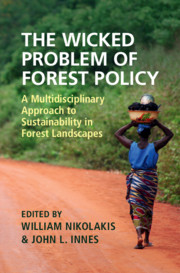 The Wicked Problem of Forest Policy
The Wicked Problem of Forest Policy Markets and Industry Structures
from Part I - Wicked Problems and Policies
Published online by Cambridge University Press: 24 July 2020
The 2030 Agenda for Sustainable Development and its Sustainable development Goals (SDGs) and the Paris Agreement on climate change provide a license to change the existing global economic model. Production and consumption needs to be transformed to be sustainable so that we can live within our planetary boundaries. An essential part of this transformation will be a forest-based circular bioeconomy, which builds on the world’s biggest land-based natural capital – forests – and the synergies of the circular economy and bioeconomy concepts. Biology, science, technology, resource efficiency and sustainability are laying the foundations for this transformation. Within this context, forest bio-based products have emerged that can substitute fossil-based materials like plastics, chemicals, synthetic textiles, cement and many other materials. This chapter analyses this ongoing transformation, focusing on forest-based products, and examines what this role looks like by exploring trends in current market structures and forest products in this transformation, and asks how will these new emerging bioeconomy markets develop? Central to this chapter are other questions such as what role do polices play in the transformation, and how do the forest companies and institutions evolve in the coming decades? It is important to acknowledge that there are many ecosystem services related to forest bioeconomy that play an even greater role in sustaining life on earth – and therefore facilitating the bioeconomy - than the products we address in this chapter.
To save this book to your Kindle, first ensure no-reply@cambridge.org is added to your Approved Personal Document E-mail List under your Personal Document Settings on the Manage Your Content and Devices page of your Amazon account. Then enter the ‘name’ part of your Kindle email address below. Find out more about saving to your Kindle.
Note you can select to save to either the @free.kindle.com or @kindle.com variations. ‘@free.kindle.com’ emails are free but can only be saved to your device when it is connected to wi-fi. ‘@kindle.com’ emails can be delivered even when you are not connected to wi-fi, but note that service fees apply.
Find out more about the Kindle Personal Document Service.
To save content items to your account, please confirm that you agree to abide by our usage policies. If this is the first time you use this feature, you will be asked to authorise Cambridge Core to connect with your account. Find out more about saving content to Dropbox.
To save content items to your account, please confirm that you agree to abide by our usage policies. If this is the first time you use this feature, you will be asked to authorise Cambridge Core to connect with your account. Find out more about saving content to Google Drive.